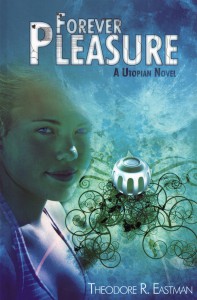A summary review of Forever Pleasure
Share
A summary review of Forever Pleasure
A utopian novel by Theodore R. Eastman
by Barbara Rodgers-Hendricks, Green Party of Florida
 At the beginning of this futuristic novel, Theodore Eastman introduces us to Jeso, a creature who, along with a couple cohorts, is engaged in a grand hedonistic expansion. He is disassembling people, atom by atom, deriving their mathematical essence and transforming the equations to best fit a hedonic identity. He then transfers the new identities into pleasure machines. He has already converted every technology-possessing species in 52,549 galaxies and over ten trillion star systems, and he now is traveling toward the planet earth.
At the beginning of this futuristic novel, Theodore Eastman introduces us to Jeso, a creature who, along with a couple cohorts, is engaged in a grand hedonistic expansion. He is disassembling people, atom by atom, deriving their mathematical essence and transforming the equations to best fit a hedonic identity. He then transfers the new identities into pleasure machines. He has already converted every technology-possessing species in 52,549 galaxies and over ten trillion star systems, and he now is traveling toward the planet earth.

Jesoís human life began on earth millenniums ago, and he often taps into those memories for his pleasure. After turning himself into a pleasure machine, he cannot imagine why everyone would not desire that existence. The core of his spaceship is two million megasize transdimensional assemblers and disassemblers. The ship has six city-sized Heim engines for speeds far faster than light.
We leave Jeso when we leave the prologue. John Seeger now takes center stage and will remain there for the remainder of the book.
John is living on earth in 1986. Johnís only significant relationship is with his sister Kayla, because he has not yet found the ìnatural woman.î Kayla is working on a scientific experiment which will, as she says, ìdetermine if the future is open, our lives freely rafting in time, or fixed and invariant, our past and future being a timeless four-dimensional object, movement being nothing but a smeared blur on a cosmic photographic plate.î While attempting to assist Kayla, John inadvertently gets trapped in the ìtime machineî and finds himself still in Yosemite, but ninety years later. Itís now 2076!
ìIíll reduce everyone to quantum-dot pleasure machines, with infinite recreational amusement and existence. Yes, forever pleasure.î From Forever Pleasure by Theodore R. Eastman
Humans inhabit the culture John finds in 2076, but run by ìsingsî which are high-speed calculators. The sings are presently trying for urban perfection, and are constantly redesigning cities, attempting to maximize everyoneís quality of life.
In this culture, the workweek is four days followed by a six-day weekend. Workers begin working at age of twenty-four and retire at forty-five. Children start school at five and begin behavioral conditioning to eliminate undesirable behaviors. Knowledge, such as the ability to speak another language is implanted by what might be called neurosurgery. As explained to John, ìA swarm of microbot surgeons grow linguistic neural networks from your DNA, put you to sleep, and embroider them throughout your cortex and sub cortical structure ñ all in four hours.î
The economy runs on an exchange where the currency is called punts, short for Personal Utopian Allotments. Everyone gets basic clothing, food, shelter, medicine, transportation, and education. Any special desires have to be earned by labor. The purpose of life is to have fun. An introduction to nano-medicine gives John the idea that he could return to 1986 and cure his sisterís diabetes which was seriously impairing her quality of life. An attempt to do that, however, lands him in the future – 5009.
In 5009, Transhumans, Posthumans, and Pole People inhabit the earth planet. A Transhuman has biological and/or machine enhancements with the purpose of moving past natural human limitations in intelligence, emotions, and aging. A Posthuman is a human who has transferred his or her pattern identity into a mechanical superior body or copied it into a computing machine for entertainment. A Pole Person is a robust, durable, and self-repairing robot that has mind-transferred the pattern identity of a biological being. The Pole Person has the optimum number and intensity of sensory pleasures.
All spoken desires are immediately manifested ñ food clothing, vehicles, whatever. (John gains the athletic body of an eighteen-year-old.) John commanded a Time Carrier to return him to the 1980s and cure his sister Kayla diabetes.
Jeso re-appears near the end of the novel in the memories of a beautiful woman for whom John has declared his love. When Johnís jealous girlfriend attacks this woman, the memories are released and Jeso takes the form of a Pole Person, the ultimate pleasure machine. Jeso declares, ìMy latest plan is to stitch the virtual particles of the quantum vacuum into an access point. From there Iíll command the underlining universe to construct itself into a hedonistic cosmos. Iíll reduce everyone to quantum-dot pleasure machines, with infinite recreational amusement and existence. Yes, forever pleasure.î
But Jeso finally succumbs to a temporal whirlwind formed by Closed Time-like Curves and vanishes. John is now free to marry his lavender-eyed, silver-haired girlfriend Jenay. Jenay assembled herself from the pattern identities of two different persons. So much for Johnís search for a natural woman!
This book could provide the springboard for an interesting discussion among Greens concerning Green ideas of Utopia.
Theodore Eastman graduated from the New York Institute and is an automation engineer for the Deep Space Network. He is contracted to NASA and the Jet Propulsion Laboratory. Eastman and his wife have two adult children and live in southern California. His book may be purchased at www.iuniverse.com.




